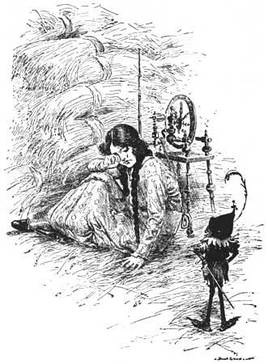|
In the Grimms' original 1810 draft of Rumpelstiltskin, the introduction is rather different.
A girl is supposed to spin some flax into yarn, but instead, whatever she spins turns into golden thread! Finally, a little man ("Rumpenstünzchen") finds her trying to spin, and tells her that he can get her out of it. He'll arrange for a prince to take her away and marry her. The price: her firstborn child. In the published editions, the Grimms used a different version, where the little man named Rumpelstilzchen offers to spin thread into gold for her. It seems they collected more versions (at least four in Hesse) and decided to use those as a basis for the published version. I feel like this was probably a good decision, because the original version is extremely short and raises a ton of questions like why is she spinning gold in the first place? They mentioned the older version in their notes as an unusual variant. Rumpelstiltskin is a weird story. There are so many questions - one of the most striking being "Why does he want her baby?" Looking at other versions of the story from around the world, in many cases, the strange little man doesn't want to take the girl's child - he wants to take her. In "Mistress Beautiful," a woman sells herself to the devil for a dowry and then escapes by guessing his name. In "Doubleturk," "Hoppetinken," "Kugerl," and others, a wealthy dwarf tries to force a girl into marrying him. Also, he doesn't always spin straw into gold. Sometimes he just does her mundane spinning for her - like the more benevolent Three Spinners, Three Aunts, or Habetrot. These female beings may be ugly, but they help the girl and ask no reward other than an invitation to her wedding. In Grimms' Bad Girls and Bold Boys, Ruth Bottigheimer went into the treatment of spinning in the Grimms' tales. Traditionally, spinning was a feminine task. All women spun. Goddesses like Athena and Holda were patronesses of weavers or spinners, and the distaff was a historical symbol of women. In popular culture, spinning became part of a homey, idyllic scene - i.e. Grandma spinning and telling stories by the fire. However, in fairytales told by women, like "Hateful Flax Spinning," you have heroines who try to get out of spinning by whatever means necessary. In editing his stories, Wilhelm Grimm added positive descriptors (beautiful, nimble, clever) for characters who worked hard at spinning. He added negative descriptors (lazy, hateful, nasty) for characters who avoided it. In “The Lazy Spinner” (no. 128) a woman tricks her husband so she doesn’t have to spin. Wilhelm’s later editions add a final line “But you yourself must own she was an odious woman!” He tried to put a good face on spinning and add in morals about hard work earning rewards. “The Spindle, the Shuttle, and the Needle” (no. 188) makes spinning look like an easy, uninvolved pastime which practically does itself. Still, you'll find details that peek through his narratives and morals. Briar Rose is cursed via spindle. The Three Spinners become hideous from years of spinning. In Rumpenstünzchen, spinning normal thread is literally impossible. And heroines in these tales are so frustrated by impossible tasks of spinning that they would even accept help from a creature which wants to steal them away or take their children. They usually get the best of this creature in the end - and by that time, they have often ascended in rank, or successfully convinced their family that they shouldn't have to spin anymore. SOURCES Text copyright © Writing in Margins, All Rights Reserved
0 Comments
Leave a Reply. |
About
Researching folktales and fairies, with a focus on common tale types. Archives
July 2024
Categories
All
|
Writing in Margins

 RSS Feed
RSS Feed
